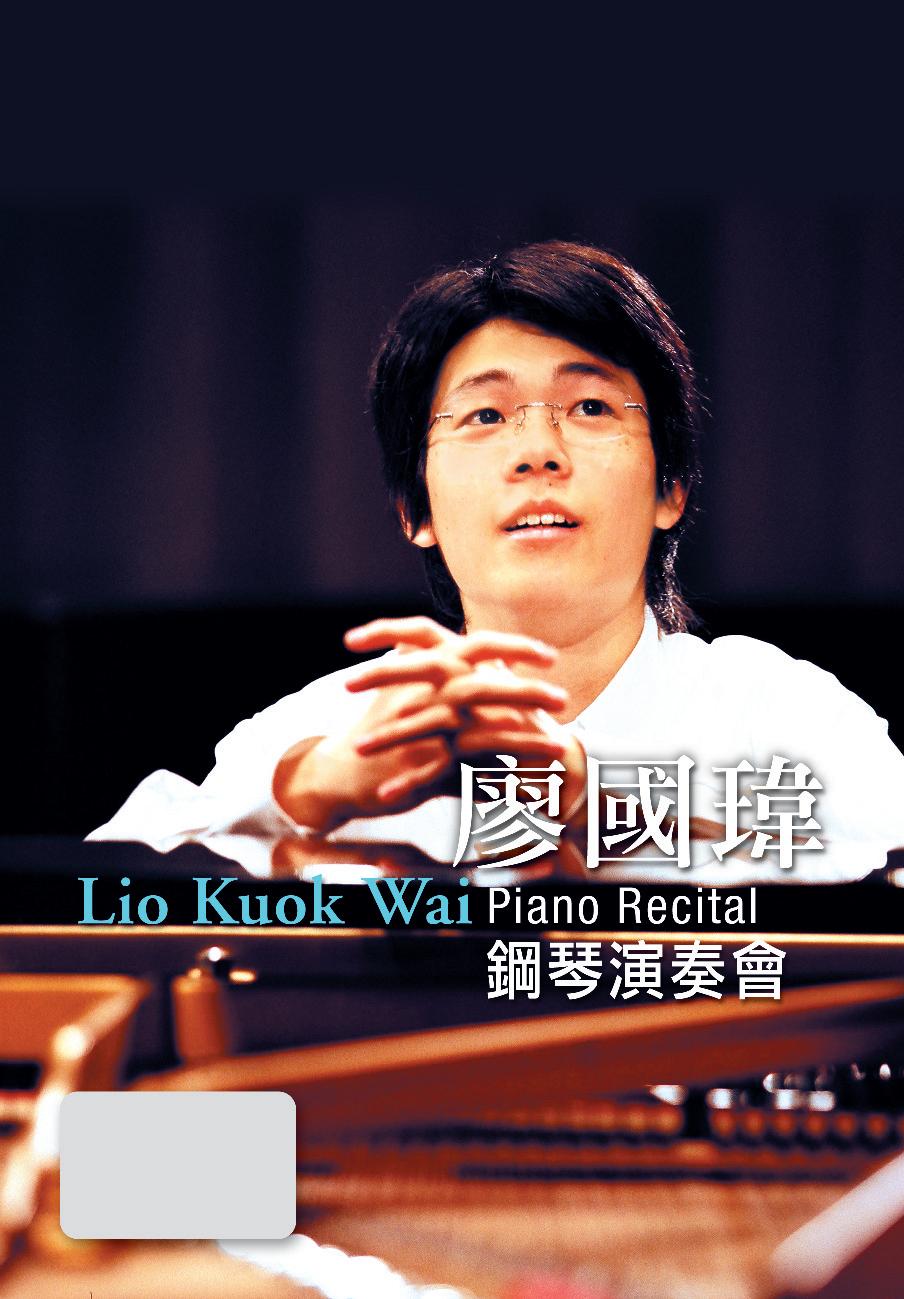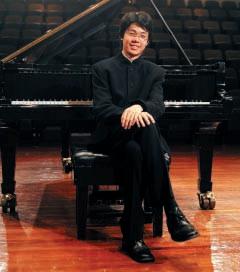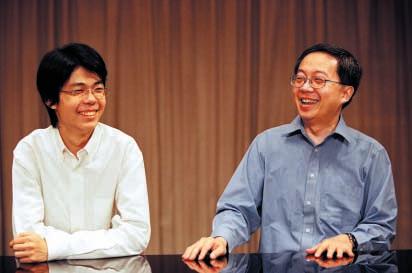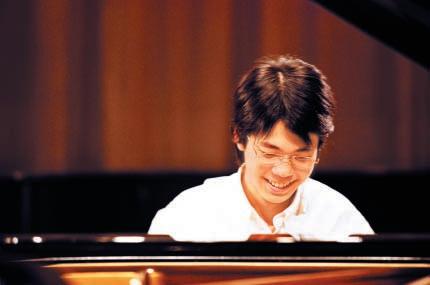
埃克森美孚新視野


埃克森美孚新視野

所有照片 All photographs © 謝明莊
11.2.2006
香港大會堂劇院 Theatre
Hong Kong City Hall
演出長約 1
Running time: approximately 1 hour and 30 minutes, including a 15 minute interval
生平介紹 Biography
節目 Programme
樂曲介紹 Programme Notes
訪問 Interview
9 14 15 29
To make this performance a pleasant experience for the artists and other members of the audience, PLEASE switch off your alarm watches, MOBILE PHONES and PAGERS. Eating and drinking, unauthorised photography and audio or video recording are forbidden in the auditorium. Thank you for your co-operation.
國瑋 1989 年生於澳門, 五歲開始習琴,師隨張 曉荔,旋於澳門青年音 樂比賽獲獎; 1997 年獲頒東方基 金獎學金,入讀香港演藝學院初 級課程,師承王南; 2000 年起師 承郭嘉特。廖國瑋現獲澳門文化 局及香港演藝學院頒發獎學金, 在香港演藝學院修讀全日制課 程。
2000 年,年僅十歲的廖國瑋在第 十一屆澳門藝術節與澳門室樂團 合作演出協奏曲,是他首次的舞 台演出; 其後獲邀在不同場合演 奏,包括第十七屆澳門國際音樂 節 (2003) 、「中法文化年音樂節」 (2004) 、由國家主席胡錦濤主禮 的澳門回歸五週年紀念慶典 (2004) 、拉斯維加斯澳門週,以 及在美國肯薩斯大學演出兩場鋼琴獨奏會 (2005) 。此外,廖國瑋也曾為香港電台及 肯薩斯公共廣播電台錄音。

2004 年 1 月,廖國瑋獲澳門政府頒發功績 獎狀,以表揚其成就。
廖國瑋曾為多個樂團擔任獨奏,計有香港 管弦樂團、香港演藝學院樂團、泛亞交響 樂團、澳門青年交響樂團、俄羅斯交響樂 團及中國愛樂樂團。
廖國瑋將於 2006 年哥蘭特斯基學院國際鋼 琴節及 2007 年美國邁亞密國際鋼琴節演 出。
Lio Kuok Wai was born in Macau in 1989 and began his piano studies at the age of five with Lilik Sutiono Cheung, achieving early success at the Macau Youth Music Competition. In 1997 he was awarded the Oriental Foundation Scholarship to further his piano studies as a Junior Student at the Hong Kong Academy for Performing Arts (HKAPA), under the tutelage of Wang Nan. Since 2000 he has been studying with Gabriel Kwok, and is currently a full-time student at the Academy endowed with scholarships from the Cultural Affairs Bureau of Macau and the Academy.
Lio made his concert debut at the age of ten with the Macau Chamber Orchestra at the 11th Macau Arts Festival. Lio has performed on various occasions including at the 17th Macau International Music Festival (2003); The Year of France and China Festival (2004); for President Hu Jintao at the 5th Anniversary of Macau’s
in Las Vegas; and in two solo recitals at the University of Kansas, USA (2005). He has also made recordings for Radio Television Hong Kong and Kansas Public Radio.
Lio has appeared as a soloist with many orchestras including the Hong Kong Philharmonic Orchestra, the Hong Kong Academy for Performing Arts Orchestra, the Pan Asia Symphony Orchestra, the Macau Youth Symphony Orchestra, the Russian Symphony Orchestra and the China Philharmonic Orchestra.
In January 2004, Lio was awarded an Honorary Diploma by the Macau Government in recognition of his achievements.
Lio will be giving recitals at the 2006 Golandsky Institute International Piano Festival and the 2007 Miami International Piano Festival in the US.

音樂獎項 Awards
2002 年 1 月
第一屆富山亞洲青少年音樂比賽
January 2002 1st Toyama Asian Youth Music Competition, Hong Kong
冠軍 First Prize
2002 年 4 月
第六十五屆史坦威國際青少年鋼琴比賽(首屆中國賽區總決賽)
April 2002 65th Steinway Youth Piano Competition (First China Regional Final), China
冠軍 First Prize
2003 年 5 月
第三屆德國塞勒國際鋼琴比賽青少年組別
May 2003 3rd Seiler International Piano Competition for Young Pianists, Germany
亞軍 Second Prize
2004 年 3 月
第五屆日本柴可夫斯基青少年國際比賽
March 2004 5th Tchaikovsky International Competition for Young Musicians, Japan
季軍 Third Prize
2004 年 7 月
第一屆美國國際學院青少年國際鋼琴比賽
July 2004 1st International Institute for Young Musicians International Piano Competition, USA
冠軍及觀眾獎 First Prize and Audience Prize
2004 年 8 月
第九屆德國艾特林根青少年國際鋼琴比賽
August 2004 9th Ettlingen International Competition for Young Pianists, Germany
第五名 Fifth Prize
2005 年 1 月
第六屆日本亞洲蕭邦國際鋼琴大賽(公開組)
January 2005 6th International Chopin Competition in Asia — General (Open) Category, Japan
金獎及特別獎 Gold Prize and Yoda Prize
2005 年 6 月 2005 美國吉娜.巴考爾青年藝術家國際鋼琴比賽
June 2005 2005 Gina Bachauer International Young Artists Competition, USA
冠軍 First Prize
加料節目 Festival Plus
演後藝人談 Meet-the-Artist (Post-Performance)
歡迎觀眾演出後留步,與廖國瑋見面
If you would like to meet Lio Kuok Wai, please stay behind in the auditorium after the performance
莫扎特 (1756-1791)
F 大調奏鳴曲, K533
快板
如歌的行板 小快板
蕭邦 (1810-1849)
《三首馬組卡舞曲》,作品 59
第一首, A 小調
第二首,降 A 大調
第三首,升 F 小調
《平靜的行板及華麗大波蘭舞曲》, 作品 22
-中場休息-
史克里亞賓 (1872-1915)
《兩首給左手的小品》,作品 9
第一首,升 C 小調前奏曲
第二首,降 D 大調夜曲
《兩首詩曲》,作品 32
第一首,升 F 大調
第二首, D 大調
葛令卡 (1804-1857)
巴拉基列夫 改編
《雲雀》
克萊斯勒 (1875-1962)
拉赫曼尼諾夫 改編
《愛的悲愁》 《愛的歡樂》
Wolfgang Amadeus Mozart (1756-1791)
Sonata in F major, K533
Allegro
Andante cantabile
Allegretto
Frederic Chopin (1810-1849)
Mazurkas, Op 59
No 1 in A minor
No 2 in A flat major
No 3 in F sharp minor
Andante Spianato and Grande Polonaise, Op 22
– Interval –
Alexander Scriabin (1872-1915)
Two Pieces for the Left Hand, Op 9
No 1 Prelude in C sharp minor
No 2 Nocturne in D flat major
Two Poems, Op 32
No 1 in F sharp major
No 2 in D major
Mikhail Glinka (1804-1857)
arranged by Mily Balakirev
The Lark
Fritz Kreisler (1875-1962)
arranged by Sergei Rachmaninoff
Liebesleid
Liebesfreud
莫扎特
F 大調奏鳴曲, K533
莫扎特F 大調奏鳴曲,K533的寫作緣起跟他大部份鋼琴奏鳴曲截然 不同。此曲的第三樂章〈小快板〉寫於 1786 年,原本打算作為一首 獨立的單樂章鋼琴迴旋曲;可是兩年後,莫扎特重拾此曲,加以修 改,並在此曲之前加上兩個樂章,組成一首多樂章奏鳴曲。跟莫扎 特許多作品一樣,在此曲透明的織體、勻稱的結構底下,內在結構 其實相當複雜。舉例說,第一樂章先以右手彈出無伴奏的簡單旋 律;不久,左手也有機會以低八度奏出這個旋律,依然不帶伴奏。 樂章的特色,在這個勻稱的開端已見端倪:開始時兩手分別單獨奏 出第一主題;而縱觀整個樂章,莫扎特不時巧妙地插入模仿段落
左右手各自參照對方的素材,有樣學樣。於是,鋼琴家雙手終 日你追我逐,幾乎通篇對位。
第二樂章速度舒徐,柔美如歌的主題展開。開始時樸實無華,只是 寥寥數個裝飾性迴音、顫音及幾次跳進而已;但旋律音域漸漸擴 大,樂句一句比一句長。莫扎特在此章一再應用這種手法,並加上 輕盈靈巧、帶即興味道的修飾,引人入勝。一如所料,第三樂章 〈小快板〉處處出人意表,趣味盎然。〈小快板〉以迴旋曲式寫成,主 題與對比插段交替出現;然而,莫扎特不但將主題、插段一前一後 地鋪排,還把主題加以變化,又選取主題內精練、顯眼的動機,滲 入插段,使這個樂章成為莫扎特結構最嚴謹的迴旋曲之一。
蕭邦
三首馬組卡舞曲,作品 59
篇幅短小的舞曲是十九世紀鋼琴曲目的核心。圓舞曲、波爾卡舞 曲、蘭德勒舞曲,還有林林總總的對舞曲,是一般鋼琴手常用的 「家常便飯」。因此,蕭邦作品中包括大量舞曲毫不足怪,而且其中 很多是為其學生而寫的。蕭邦共創作了五十餘首馬組卡舞曲 他 之所以對這種舞曲情有獨鍾,其一是它跟波蘭舞曲一樣,都是源自 波蘭。事實上,蕭邦這位波蘭裔音樂家,年幼時曾在馬佐維亞省生 活過,而人們普遍認為馬佐維亞省正是馬組卡舞曲的發祥地。
此作品寫於 1845 年,可算是最複雜的馬組卡舞曲。三首舞曲開始 時,主題配合馬組卡舞曲的特色節奏,使每小節第一拍的重音移至 第二或第三拍。別看開端簡單明白,變化和聲不久就把調性越拉越 遠,卻又不失馬組卡舞曲的節奏動感,使樂曲外表流麗優雅,而和 聲色彩則豐富多變。
-中場休息-
22
蕭邦以「平穩的」一詞(源自意大利語,意指「不間斷」),指示演奏者 以流暢、不間斷的方式演繹這個寬廣的「行板」,作為稍後大型波蘭 舞曲的引子。可是,「行板」絕非僅僅是波蘭舞曲的附屬品而已 這部份本身已經很完整,要獨立成曲其實易如反掌。「行板」的開端 像極了蕭邦其中一首夜曲,旋律恬靜平和,配上大量裝飾音;雖有 和弦式中段,但整個「行板」仍受夜曲流麗的線條支配。波蘭舞曲圍 繞多個稜角分明的莊嚴旋律寫成,伴以這種舞曲典型的重複節奏 型,與「行板」迥然不同;曲中艱深樂段不少,反映此曲本為炫燿高 超技巧而寫。蕭邦原作以管弦樂伴奏鋼琴,但現在常見的則是鋼琴 獨奏版本 把管弦樂曲當鋼琴獨奏曲演奏的傳統,正是由蕭邦 本人開創。
史克里亞賓 《兩首給左手的小品》,作品 9
史克里亞賓年輕時鑽研過前輩蕭邦的音樂,而人們也愛把史氏早期 作品與蕭邦的相提並論。可以肯定,史氏決心創作夜曲及前奏曲, 清楚顯示他見賢思齊。然而,作品 9 兩首樂曲皆為左手而作的原 因,卻是出於實際需要,跟蕭邦毫無關係: 1890 年代,一心要成 為鋼琴演奏家的他,顯然因過度練習李斯特和巴拉基列夫的作品, 導致右手受傷。既然右手暫時不能勞累,史氏於是創作合適的樂 曲,讓他能用健康的手繼續彈奏。
作品 9 的兩首作品相映成趣:《前奏曲》織體比較玲瓏通透,單純率 真;但小調調性卻使樂曲被重重陰霾籠罩,直至感覺較親切的降 D 大調《夜曲》時才消散。細心的聽眾會發現,儘管音名不同,兩首樂 曲主音卻相同:升 C 跟降 D
是等音,意即在鋼琴鍵盤上,這兩個音 是以同一黑琴鍵彈奏的。故此,《前奏曲》與《夜曲》在調性上尚可組 成一對,使兩曲關係更密切。
史克里亞賓
《兩首詩曲》,作品 32
在十九、二十世紀之交,史克里亞賓對神秘哲學的興趣日趨濃厚, 最終自己的美學原則自然也受影響。作品 32 寫於 1903 年,偶有評 論指第一首就是史氏風格的轉捩點。升 F 大調《詩曲》旋律與伴奏徐 徐開展,朦朦朧朧、恍恍惚惚,和聲彷彿凝住了,沒有明確目標或 方向。柔和音量與彈性速度的運用,使樂曲氣氛如夢如幻、自由奔 放。如果說第一首《詩曲》呈現迷糊恍惚的狀態,第二首就把我們帶 到緊張刺激的世界。雖然作曲家指示演奏者要優雅、表現信心,但 此曲不單速度快,連配以三連音伴奏的旋律也顯得焦慮不安;再 者,旋律起伏甚大,任憑旋律如何優雅,也帶幾分冷峻尖銳。
葛令卡 巴拉基列夫 改編 《雲雀》
克萊斯勒 拉赫曼尼諾夫 改編
《愛的悲愁》
《愛的歡樂》
鋼琴用途廣泛,是演奏改編曲的理想樂器。最優秀的改編曲是原曲 的再創作,由不同媒介呈現原曲的不同面貌 今天演奏的三首 改編曲皆屬此類。
《愛的悲愁》和《愛的歡樂》屬沙龍音樂,是小提琴家克萊斯勒其中 兩首最著名的作品;二者皆魅力迫人,感染力強,一如克萊斯勒顛 峰水平的沙龍音樂。原作旋律優美動人,拉赫曼尼諾夫也忠於原有 旋律,改編時讓主題清晰呈現,鮮有改動,只是着力潤色伴奏,並 自原作取材,寫成令人喜出望外的引子和過渡段。相反,巴拉基列 夫改編葛令卡歌曲《雲雀》的手法則截然不同:雖然大致保留了原作 的和聲,但改編者也隨心所欲地修飾原作,添上大量倚音和半音裝 飾,務求達至更佳的鋼琴獨奏效果。
樂曲介紹:麥嘉倫 場刊中譯:鄭曉彤
The genesis of Mozart’s Sonata in F major, K533, differs from that of most of his other keyboard sonatas. He composed the concluding Allegretto of this work in 1786, and initially intended it to stand alone as a single-movement rondo for the piano. However, two years later, he revisited the piece, revised it and added the first two movements to create a multi-movement sonata.
Like so much of Mozart’s music, this sonata’s transparent textures and balanced structures conceal a great deal of complexity. For example, the Allegro begins with a simple unaccompanied melody played by the right hand. A short while later the left hand is given its chance to repeat this tune an octave lower, again without accompaniment. This symmetrical opening in which each hand states the principle theme alone provides an understated clue to the entire movement, for throughout it Mozart cleverly inserts points of imitation in which one hand mimics the other. In this way, the pianist’s two hands chase one another from beginning to end in what is an almost continuous flow of counterpoint.
In the slow, central movement of this sonata, a beautiful cantabile or songlike theme is developed. It begins modestly enough, with a few ornamental turns, trills and modest leaps. Nonetheless, the range of the melodic line gradually increases over the course of the movement, while at the same time each phrase grows longer than the previous one. This process is repeated over the course of the Andante , imbuing it with an attractive suppleness that recalls improvisation. Not surprisingly, the Allegretto at the end of the sonata is also a source of pleasant surprises. It is in the form of a rondo, in which a refrain alternates with contrasting episodes. Here, Mozart not only uses the refrain to frame the episodes, he also varies the refrain and introduces brief but telling motivic references to it within the episodes, making this movement one of his most highly unified rondos
Mazurkas, Op 59
Short dance pieces were a staple of the 19th century piano repertory. Waltzes, polkas, ländler and a variety of contradances formed a goodly portion of the musical diet of the average pianist. Not surprisingly, Chopin produced a large body of dance pieces, including over 50 mazurkas, many written with his own students in mind. His particular fondness for the mazurka stems, in part, from the fact that it came, like the polonaise, from Poland. Indeed, the Polish-born composer spent part of his youth in the province of Mazovia, where the mazurka is thought to have originated.
Composed in 1845, the mazurkas of Chopin’s Opus 59 are among the most complex examples of this genre. All three begin with deceptive simplicity as Chopin introduces the main themes, which are accompanied by that most characteristic feature of the mazurka, a shift of accent from the first beat to either the second or third beats of each measure. Shortly after these opening gambits, chromatic harmonies begin pulling us toward increasingly remote tonal areas, yet without ever disturbing the rhythmic momentum of the dance. Thus, he combines a smooth, polished surface with a harmonic fabric of great colour and variety.
Chopin used the word spianato (derived from the Italian spiano, meaning without a break) to indicate a smooth, unbroken performance style for the expansive Andante that serves as the introduction to a large-scale polonaise. This Andante, however, is no mere appendage prefixed to the dance that follows; it could easily stand alone as an independent, self-contained work. The texture of its opening is reminiscent of one of his nocturnes, with a languorous melody that gives rise to a profusion of ornament. Although this texture eventually yields to a chordal, middle section, it is the flowing lines of the nocturne that dominate. By way of contrast, the Polonaise is organised around an abundance of somewhat angular yet stately melodies that are supported by the repetitive rhythmic figures so typical of that dance. The amount of difficult passagework in the Polonaise reflects its original function as a showpiece for a virtuoso performer. Although initially intended as a work for piano with orchestral accompaniment, it is now most frequently heard in a solo piano version, a tradition that Chopin himself inaugurated.
Scriabin’s early musical works are often compared to those of Chopin, which the younger composer had studied closely. Certainly, his decision to compose nocturnes and preludes strongly suggests that he wished to emulate Chopin. The fact that these two pieces were written for the left hand, however, has nothing to do with the Polish composer, but was the result of practical concerns. Scriabin, who studied to be concert pianist, apparently injured his right hand in the early 1890s from over-practicing the music of Liszt and Balakirev. His response to this temporary physical limitation was to compose works that would allow him to continue playing with his good hand.
The two pieces of Opus 9 complement one another nicely. The Prelude possesses a relatively transparent texture and unaffected melody, but its minor tonality imparts a weighty darkness that is only dispelled with the warmer sounds of the Nocturne’s D flat major. The careful listener, however, will notice that despite their different names, the keys of these two pieces actually share the same tonic, or home pitch. C sharp and D flat are enharmonic, meaning that on the piano’s keyboard, they are played by striking the same black key. The Prelude and Nocturne, therefore, form a tonal pair of sorts, linking them even more closely.
At the turn of the 20th century, Scriabin grew increasingly attracted to mystical philosophies, and this new interest would ultimately influence his aesthetic principles. Critics occasionally point to the first of the two pieces from the composer’s Opus 32, written in 1903, as marking the start of this change. With its hypnotic unfolding of melody and accompaniment, the Poem in F sharp major generates a sense of harmonic stasis in which there is no apparent goal or direction. Instead the piece establishes a rhapsodic, dreamlike atmosphere that is enhanced by a generally soft dynamic level and the use of rubato. If the first poem suggests a trance-like state, the second moves us to a world of nervous excitement. Although Scriabin tells the performer to strive for elegance and confidence, the triplets of the accompaniment lend an anxious quality to the right hand melody that is further intensified by the Poem’s quick tempo. Moreover, the angular contour of the melody gives whatever elegance it possesses a somewhat brittle edge.
arranged by Mily Balakirev
The Lark
Fritz Kreisler
arranged by Sergei Rachmaninoff
Liebesleid
Liebesfreud
The piano’s versatility has made it an excellent instrument for arrangements of music originally intended for other performing forces. The best of these works are re-creations of the original, employing a different medium to bring new perspectives to an existing work. All three of the arrangements performed in this recital fall into this category.
Liebesleid (Love’s Sorrow) and Liebesfreud (Love’s Joy) are two of the violinist Fritz Kreisler’s most familiar pieces, and both exude the infectious charm that is characteristic of his best salon music. Rachmaninoff’s settings pay homage to Kreisler’s melodic talents by presenting the themes clearly with very little alteration, while expanding the accompaniment texture and adding introductory and transitional sections that develop material drawn from the original pieces in an exhilarating manner. In contrast, the Russian Balakirev used a markedly different approach for his arrangement of Glinka’s song The Lark. Although he adhered quite closely to the harmony of the original, Balakirev freely decorated the older composer’s melody with numerous appoggiaturas and chromatic ornaments in order to produce a more satisfying piano solo.
Programme Notes by Michael McClellan

廖國瑋:音樂就是生命
「每次演出,我最大的樂趣是能夠即時與每位聽眾分享自己對樂章的 感受和演繹。」
文: Jonathan Ho
溫
暖的初冬下午,筆者坐在演藝學 院一樓平台的鋼琴旁,欣賞青年 鋼琴家廖國瑋應筆者要求,演奏 蕭邦的《平靜的行板及華麗大波蘭舞曲》。
在演奏時舉手投足間,甚或整個訪問中, 廖國瑋都流露着比他實際年齡成熟的音樂 家風範。
事實上,年僅十六歲的廖國瑋在鋼琴藝術 上已取得優越的成績,除了去年六月於美
國鹽湖城吉娜.巴考爾國際青年藝術家鋼 琴比賽奪魁,去年初亦取得於東京舉行的 第六屆蕭邦國際鋼琴大賽公開組冠軍,以 及 2004 年日本第五屆柴可夫斯基青少年國 際鋼琴大賽季軍。
儘管國際賽事經驗豐富,廖國瑋對參加音 樂比賽自有一套看法:「其實我不太喜愛參 加比賽!比賽場上有太多優秀的參賽者(可 供觀摩、切磋),若參加比賽只為奪取獎 項,壓力大之餘,更失去參賽的意義。」
那麼參加比賽對廖國瑋又有何意義?「參加 比賽可以開拓更多的音樂經驗,除了可以 鍛練自己的膽量,更可以從不同的參賽者 和評判中學習及豐富自己的音樂造詣。我 相信要是我能應付比賽的挑戰,必定能應 付音樂會的要求。」他又補充說:「音樂或 藝術比賽與奧林匹克運動會不同,奧林匹 克講求的是眾人公認的秒數、速度等理性 的標準,但音樂比賽的標準則比較主觀, 而且往往有不少政治因素在背後。」
除了參賽經驗,廖國瑋還擁有豐富的音樂 會經驗,於美國肯薩斯舉行獨奏會之外, 也先後與俄羅斯交響樂團、中國愛樂樂團 及港樂同台演出。獨奏及參與音樂會演出 的經驗又為廖國瑋帶來什麼感受呢?「每次 演出,我最大的樂趣是能夠即時與每位聽 眾分享自己對樂章的感受和演繹。」
注重其他藝術養份
為此,廖國瑋在每個音樂會前,都會把握 時間多作練習,除了樂章及技巧方面的鍛 練,廖國瑋更注重其他藝術修養,以提昇 自己的音樂造諧,如演奏蕭邦或舒伯特作 品時,他會盡量多聽其他名鋼琴家如傅 聰、布倫德爾、魯賓斯坦的演奏,以學習 大師級的技法,而演奏莫扎特作品時,則 會欣賞莫扎特的歌劇,因為「莫扎特的作品 充滿詩情畫意,就彷如水彩畫般色彩斑斕 多姿,不同的段落,代表着不同的角色!」 此外,廖國瑋也會抽空欣賞繪畫及書法來 潤澤自己的藝術表現。
反過來,廖國瑋對聽眾又可有什麼要求 呢?「我希望觀眾可以專心地欣賞台上的演 出,他們或者不知道,演奏廳內此起彼落 的咳嗽聲,脫外套時發出窸窸窣窣的聲 音,都會對表演者造成滋擾。」
廖國瑋更提醒各位家長,切勿強迫小孩子 進場,「小朋友未必都有耐性安靜地在座位 上欣賞演奏,當我做觀眾的時候,如果鄰 座是一位坐不安定的小朋友,對我欣賞音 樂會的心情也會有影響。」作為表演者,廖 國瑋正在學習如何在演出時心神專注,不 受環境影響;但作為觀眾,他還是希望可 以不受干擾地欣賞台上的演出。
要像孟子般優秀,背後必有賢慧的孟母, 廖國瑋這位卓越的青年鋼琴家背後,就有 這麼一位慈母;喜愛藝術的廖媽媽,對廖 國瑋和他的哥哥廖國敏的藝術修為,起了 潛移默化的影響。兩兄弟自少就在媽媽的 循循啟導下,接觸繪畫、書法及古典音 樂,不過廖媽媽對兒子的藝術種籽,從沒 有強施肥料以催促成長。自幼與媽媽感情 很好的廖國瑋表示,「若媽媽迫我聽音樂 會,迫我彈琴,我一定不會愛上音樂藝 術;但剛好相反,她經常勸我不要整天埋 頭練琴,叮囑我要多做運動!」
雖然廖國瑋每天大部份時間都坐在鋼琴 前,卻原來他並不怎麼喜歡練琴,只因為 熱愛音樂,明白練習彈琴有助他認識音 樂。那麼,他會怎樣形容自己跟音樂的關 係呢?廖國瑋想也不用想就引用了鋼琴家 魯賓斯坦的名言「Music is life」(音樂就是 生命)。
“Each time I perform, my greatest pleasure lies in the immediacy of sharing my feelings for and interpretations of music with each member of the audience.”
by Jonathan Ho
On a warm autumn afternoon, I sat beside the piano on the mezzanine floor of the Hong Kong Academy for Performing Arts listening to young pianist Lio Kuok Wai, who was playing Chopin’s Andante Spianato and Grande Polonaise at my request. His performance at the piano and during the interview showed him to be a seasoned musician much older than his actual age.
In fact, Lio, at the age of only 16, has already proved his excellence. Apart from winning the Gina Bachauer International Young Artists Competition at Salt Lake City, USA, he also came first in the 6th Chopin International Piano Competition in Asia (Tokyo) in 2005, and came third in the 5th Tchaikovsky International Competition for Young Musician (Japan) in 2004.
Despite ample experience in international competitions, this young musician states forthrightly: “Actually, I’m not too fond of taking part in competitions!” His outlook on these events is: “There are just too many outstanding competitors and if taking part in these competitions were just to win them, then apart from the pressure, the entire meaning of taking part would be lost.”
In that case, just what meaning do these competitions have for Lio? “Taking part in competitions opens up greater music experiences. Apart from honing my courage, they are an opportunity to learn and enrich myself by seeing and hearing the other competitors and from studying the critiques given. I believe that by coping with the challenges of competitions, I will be able to cope better with the demands of a concert.” He added: “A music or artistic competition is not the same as a competition in the Olympic Games. The Olympics call for faster times or publicly recognised objective goals; a music competition’s standards are more subjective, and there frequently are political elements involved.”
Aside from competitions, Lio has also had ample concert experience. Apart from a recital in Kansas City, he has also played with the Russian Symphony Orchestra, the China Philharmonic Orchestra and the Hong Kong Philharmonic Orchestra. What does Lio feel about these recitals and concerts? “Each time I perform, my greatest pleasure lies in the immediacy of sharing my feelings for and interpretations of music with each member of the audience.” Because of this, Lio practices intensely before each concert. Apart from

increasing his knowledge of the score and the techniques, he also pays attention to the underlying musicality and heightens his own music formation. When he is to play Chopin or Schubert, he will listen to as many other pianists as possible Fou Ts’ong, Alfred Brendel, Arthur Rubinstein. When it’s to be a Mozart piece, he’ll listen to Mozart’s operas because “Mozart’s works are full of poetry and art. It’s like a watercolour in its gorgeous colour, with different sections representing different roles in the opera!” In addition, Lio also takes time to look at paintings and calligraphy to lubricate his own artistic performance.
On the other hand, what does Lio demand of his audience? “I’d like the audience to concentrate on the performance. They may not realise that every cough, every adjustment of a coat will be magnified and disturb the performer.” He also reminds
parents not to force small children to attend concerts. “Small children may not have the patience to sit quietly and listen. When I am a part of the audience, my appreciation of the performance will be affected if a restless child is sitting beside me.”
As a performer, Lio is learning how to concentrate while performing so that he remains unaffected by the environment. As a part of the audience, he also hopes to remain undisturbed as he listens to a performance.
Encouraging this surpassing young musician has been Mrs Lio, his arts-loving mother, who is the influence behind Lio and his brother’s artistic sensibilities. Through their mother the two brothers were exposed to paintings, calligraphy and classical music. But the seeds she sowed were never forced and never fertilised too vigorously. Lio is very close to his mother: “If mother had forced me to listen to music, to play the piano, I would not have developed a love for music. Instead she often urged me not to spend so much time at the piano, but to go out and take part in sports!”
Even though Lio spends most of his day at the piano, he doesn’t really like practicing. It’s just that he loves music and realises that practising helps him in his knowledge of music. In that case, how would he describe his relationship with music? Unhesitatingly, Lio quotes the pianist Rubenstein: “Music is Life”.
Translated by Pan Shih